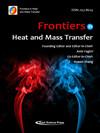一种新型自成型风冷蓄电池架的研究
IF 1.1
Q4 THERMODYNAMICS
引用次数: 0
摘要
用于储能系统的锂离子电池在运行过程中会释放大量的热量。如果不及时消散,将造成严重的热失控后果。本研究在常规储能电池架的基础上,结合储能电池本身的形状,建立了储能系统的自成型风冷电池架。电池架的框架作为风道,大大降低了系统的复杂性。本文在实验的基础上建立了热生成模型,并对四种电池架形式进行了CFD仿真研究。分析了两级并联结构的流动均匀性、电池的最高温度、电池架的温差和总压降。研究发现,由于采用锥形风道,CaseⅣ形式的自成型电池架具有最高的流速和温度均匀性。箱式Ⅳ在增加流量时也能抵抗流动不均匀性。在46 g/s流量下,在0.5℃下最高温度可保持在33.8℃。电池与单体电池内部的最大体温差分别小于3.8℃和10℃。压降仅为4.8 Pa。此外,CaseⅣ在92 g/s流量下达到最佳冷却性能,最大体温为31.8℃,压降为19.5 Pa。本文章由计算机程序翻译,如有差异,请以英文原文为准。
RESEARCH ON A NOVEL CONCEPT OF SELF-FORMING AIR COOLING BATTERY RACK
Lithium-ion batteries used for energy storage systems will release amount of heat during operation. It will cause serious consequences of thermal runaway if not dissipate in time. In this study, a self-forming air-cooled battery rack of the energy storage system is established based on the normal battery rack for energy storage and the shape of the energy storage battery itself. The frames of the battery rack acts as air ducts, which greatly reduce the system complexity. In this paper, the heat generation model is established based on the experiment, and the four battery rack forms are studied by CFD simulation. The flow uniformity of the two-level shunt structure, the maximum temperature of the battery, the temperature difference and the overall pressure drop of the battery rack are analyzed. It was found that the self-forming battery rack in the form of Case Ⅳ has the highest flow rate and temperature uniformity due to the tapered air ducts. Case Ⅳ can also resist flow non-uniformity when increase the flow rate. The maximum temperature can be maintained at 33.8 o C at 0.5 C under the 46 g/s flowrate. Where the maximum bulk temperature difference between batteries and inside a single battery is less than 3.8 o C and 1 o C, respectively. The pressure drop is only 4.8 Pa . What’s more, Case Ⅳ achieves optimal cooling performance at a 92 g/s flow rate, under which the maximum bulk temperature is 31.8 o C with the pressure drop of 19.5 Pa.
求助全文
通过发布文献求助,成功后即可免费获取论文全文。
去求助
来源期刊

Frontiers in Heat and Mass Transfer
THERMODYNAMICS-
CiteScore
2.50
自引率
61.10%
发文量
66
审稿时长
10 weeks
期刊介绍:
Frontiers in Heat and Mass Transfer is a free-access and peer-reviewed online journal that provides a central vehicle for the exchange of basic ideas in heat and mass transfer between researchers and engineers around the globe. It disseminates information of permanent interest in the area of heat and mass transfer. Theory and fundamental research in heat and mass transfer, numerical simulations and algorithms, experimental techniques and measurements as applied to all kinds of current and emerging problems are welcome. Contributions to the journal consist of original research on heat and mass transfer in equipment, thermal systems, thermodynamic processes, nanotechnology, biotechnology, information technology, energy and power applications, as well as security and related topics.
 求助内容:
求助内容: 应助结果提醒方式:
应助结果提醒方式:


